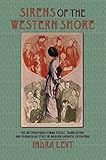Sirens of the Western Shore : The Westernesque Femme Fatale, Translation, and Vernacular Style in Modern Japanese Literature / Indra Levy.
Material type: TextPublisher: New York, NY : Columbia University Press, [2006]Copyright date: ©2006Description: 1 online resource (344 p.)Content type:
TextPublisher: New York, NY : Columbia University Press, [2006]Copyright date: ©2006Description: 1 online resource (344 p.)Content type: - 9780231137874
- 9780231510745
- 895.6/093522
- PL726.58.W64 L58 2006
- PL726.58.W64 L58 2006
- online - DeGruyter
- Issued also in print.
| Item type | Current library | Call number | URL | Status | Notes | Barcode | |
|---|---|---|---|---|---|---|---|
 eBook
eBook
|
Biblioteca "Angelicum" Pont. Univ. S.Tommaso d'Aquino Nuvola online | online - DeGruyter (Browse shelf(Opens below)) | Online access | Not for loan (Accesso limitato) | Accesso per gli utenti autorizzati / Access for authorized users | (dgr)9780231510745 |
Frontmatter -- Contents -- Acknowledgments -- Introduction -- Part One: Foreign Letters, the Vernacular, and Meiji Schoolgirls -- Introduction -- 1. Translation as Origin and the Originality of Translation -- 2. Meiji Schoolgirls in and as Language -- Part Two: Tayama Katai and the Siren of Vernacular Letters -- Introduction -- 3. Portrait of the Naturalist as a Young Exote -- 4. Literary Desire and the Exotic Language of Love: From "Shōshijin" to Jokyōshi -- 5. Haunting the Laboratory of Vernacular Style: The Sirens of "Shōjobyō" and Futon -- Part Three: Staging the New Woman. The Spectacular Embodiment of "Nature" in Translation -- Introduction -- 6. Setting the Stage for Translation -- 7. Gender Drag, Culture Drag, and Female Interiority -- Final Reflections: Gender, Cultural Hierarchy, and Literary Style -- Notes -- Bibliography -- Index
restricted access online access with authorization star
http://purl.org/coar/access_right/c_16ec
Indra Levy introduces a new archetype in the study of modern Japanese literature: the "Westernesque femme fatale," an alluring figure who is ethnically Japanese but evokes the West in her physical appearance, lifestyle, behavior, and, most important, her use of language. She played conspicuous roles in landmark works of modern Japanese fiction and theater.Levy traces the lineage of the Westernesque femme fatale from her first appearance in the vernacularist fiction of the late 1880s to her development in Naturalist fiction of the mid-1900s and, finally, to her spectacular embodiment by the modern Japanese actress in the early 1910s with the advent of Naturalist theater. In all cases the Westernesque femme fatale both attracts and confounds the self-consciously modern male intellectual through a convention-defying use of language. What does this sirenlike figure reveal about the central concerns of modern Japanese literature? Levy proposes that the Westernesque femme fatale be viewed as the hallmark of an intertextual exoticism that prizes the strange beauty of modern Western writing.By illuminating the exoticist impulses that gave rise to this archetype, Levy offers a new understanding of the relationships between vernacular style and translation, original and imitation, and writing and performance within a cross-cultural context. A seamless blend of narrative, performance, translation, and gender studies, this work will have a profound impact on the critical discourse on this formative period of modern Japanese literature.
Issued also in print.
Mode of access: Internet via World Wide Web.
In English.
Description based on online resource; title from PDF title page (publisher's Web site, viewed 02. Mrz 2022)


